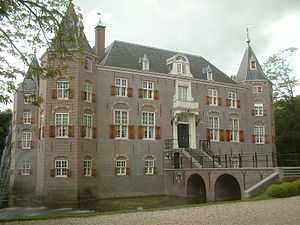Jan Hope

John Hope (14 February 1737, Amsterdam - 1784), also known as Jan Hope, was the son of Thomas Hope and Margaretha Marcelis, first cousin of Henry Hope, father of Thomas Hope, and a follower of the Scottish Enlightenment, who is best known today for his Groenendaal Park in Heemstede, Netherlands, where he summered from 1767 to his death in 1784.
Early years
Jan was an only child, born into the famous Hope banking family of Rotterdam and Amsterdam. His father had been the personal advisor to the stadtholder William V. His mother was a daughter of the wealthy Amsterdam merchant Jan Marcelis. Originally baptized as Jan in the Mennonite church, he had himself re-baptized John in the Dutch Reformed church at age 26 in order to become socially accepted in the Amsterdam regency. Unlike his cousin and business partner Henry, Jan wanted to participate in the fashionable Dutch societies that actively propagated the Scottish enlightenment. For this he needed a title and the proper religion. He became a member of the Dutch Society of Science and the Dutch Society of Letters (there he was introduced by no other than the director himself, David Ruhnken), but only after he had married Philippina Barbara van der Hoeven (1738-1790), the daughter of a Rotterdam mayor, in May 1763 and bought the castle Nederhorst den Berg for the title. Jan and Philippina had three sons, Thomas Hope (1769–1831), Adrian Elias (1772-1834), and Henry Philip (1774-1839).
Fire Machine
After observing the 'fire engine' on display at Leiden University, he wrote to James Watt and Matthew Boulton and had his own 'fire machine', the first steam engine for a garden, installed on the high wooded grounds of his summer home. The park he purchased and expanded was located on a high sandy ridge of dunes between the Leidsevaart and Harlem Lake. He used the steam engine to pump water into his gardens, which was highly unusual, since most Dutchmen of his day were trying to discover ways of pumping water out of places. The windmill he had previously installed proved unable to provide enough water on windless days for his richly planted garden in the English style. The steam engine was installed in 1781, and worked until well after the French occupation in the 1820s. In 1842 it was broken up, for even as a curiosity it could no longer hold out against the much larger steam boiler of the Cruquius pumping station down the road.
His son Adrian Elias embellished Groenendaal Park still further, including the Belevedere, a tower that has stood for a century on the hill behind the Vrijheidsbeeld, and the Walvisbank, a park bank made up of whale bones.
Banking business
Jan lived and worked in the Hope & Co. Amsterdam banking offices, but not very enthousiastically. Unlike his cousin, he was more interested in his summer estates, titles and show. His cousin Henry humored him and let him expand the joint art collection, used to impress the clients (often foreign heads of state). In this way, Jan's oldest son Thomas Hope (1769–1831) became a connoisseur of neoclassical interior decoration, his second son an innovative gardener, and his youngest son a gem collector and jewelery specialist. The Hope cousins were responsible for building up the parks Groenendaal in Heemstede and the Hout in Haarlem, the two largest city parks in the area. After Jan Hope died in 1784, the boys were brought up by their mother, who kept the Heemstede property Bosbeek and received visitors there to view the gardens with the many follies and her large art collection. After she died, the boys became the wards of Henry Hope, and when he fled the country in 1794, he took the boys and as much art they could carry to London. The Heemstede and Haarlem estates were left in the hands of Henry Hope's ward John Williams Hope, as was the Amsterdam banking office. Later only Adrian Elias returned to the Netherlands, spending the rest of his life working on the gardens of Groenendaal and Bosbeek.
References
- John Hope in the Vroedschap van Amsterdam (1578–1795), by Johan Engelbert Elias, Volume 2, 1905, Amsterdam, on historici.nl
- Groenendaal. Albumuitgave van de Vereniging Oud-Heemstede-Bennebroek (VOHB), 1978.
- Hans Krol. Geschiedenis van het buitengoed Bosbeek en van het adellijk geslacht Van Merlen. Heemstede, VOHB, 1987.
|